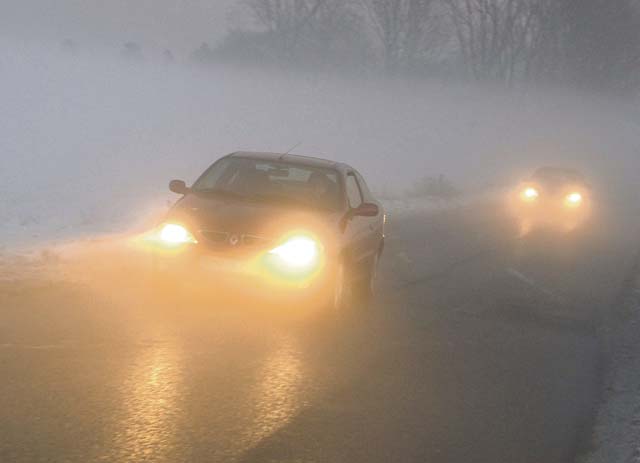
Motorists have to be extremely careful when driving in fog. Speed should be reduced and lights must be turned on.
Motorists must be extremely careful during fall months by being aware of dangers on the road, including fog, storms, black ice and wildlife crossings.
According to the German automobile club and Polizei officials, there are ways to safely get through these seasons.
• Whenever there is dense fog, a general rule is to slow down, drive even more carefully and always have the lights turned on.
• Adjust your speed to the range of sight. If visibility is only 50 meters ahead, don’t drive faster than 50 kilometers per hour. If it is 100 meters, don’t drive faster than 80 kph, and if visibility is 150 meters, don’t drive faster than 100 kph.
• Focus on the safety poles, not the center stripes. The poles on the right side of the road always have rectangular reflectors, and those on the left have two round reflectors. The density of fog can be estimated by the distance of those safety poles. On regular roads, the distance between two poles is 25 meters, and on the autobahn it’s 50 meters. Last year, there were 386 injury accidents related to fog, so motorists should be cautious.
• Motorists should also reduce their speed while driving through forest areas. During daylight and dusk hours, wild animals become more active and can dart out in front of vehicles on the road. If wild animals suddenly appear, motorists should brake immediately, turn down the lights and blow the horn. Do not swerve to avoid hitting the animal; swerving can cause the motorist to lose control of the vehicle. On streets with deer crossing traffic signs, motorists should drive cautiously and anticipate any animals that might venture onto the roadway.
In the event of an accident with an animal, turn on the warning lights, secure the vehicle, call the police and care for any injured people. The injured or dead animal should never be approached or touched; the animal may still be alive and kick out, or the animal could be infected with rabies.
In Germany, it is considered poaching if somebody takes a deer carcass off the road and brings it home. Doing so can result in the confiscation of the vehicle and a fine. In some cases, a prison sentence of up to five years is possible.
If a motorist gets in an accident involving a wild animal, the car owner needs a written confirmation by the police or the game lessee so the comprehensive insurance will pay for the damage. The game lessee follows animal protection laws and is obliged to find the injured animal and put it out of its misery.
In 2012, more than 3,000 motorists were involved in animal-related accidents. More than 600 people were severely injured and 20 died.
• Autumn is usually the time when black ice first occurs. Pay special attention to the roadway during this time of the year.
• During this time of year, agricultural vehicles often make the roads dirty with gravel and mud, creating dangerous road conditions, especially for motorcyclists. Dirt on the road, mixed with moisture, can create slippery street surfaces.
• Heavy winds or storms can also cause road dangers and obstacles. Driving in these elements, motorists should adjust their speed, be careful when passing trucks or busses, and watch for signs on bridges and in forests indicating special weather conditions.
Motorists should also refrain from parking under trees during windy or story weather; falling branches can damage vehicles and injure passengers.







